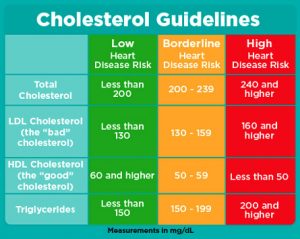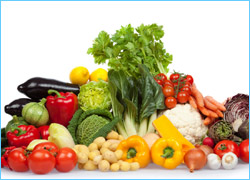Cholesterol is a type of fat that is essential for many metabolic processes. It is produced by your body and also found in food. While it is needed for good health, too much cholesterol can damage your arteries and increase your risk of heart disease. Cholesterol is carried in the blood by lipoproteins. The main types of lipoproteins are high-density lipoprotein (HDL) and low-density lipoprotein (LDL). HDL (High density lipoprotein) is the ‘good’ cholesterol because it helps remove excess cholesterol out of the cells, including cells in the arteries. and LDL (Low density lipoprotein) is the ‘bad’ cholesterol. Eating foods rich in saturated fats will increase the amount of LDL cholesterol in the body, which is a risk factor in coronary heart disease.
Triglycerides are a type of fat in your blood, which can also increase your risk of heart disease. Triglycerides are usually tested along with cholesterol when you have a cholesterol blood test. The tests for total cholesterol, HDL cholesterol, LDL cholesterol and triglycerides are known as a lipid profile.
High cholesterol foods are often foods that are also high in saturated fats. These foods should be limited in a healthy diet. The cholesterol in your diet comes mainly from eggs and from animal products that are rich in fat such as meats and full fat dairy foods. All foods from animals contain some cholesterol. Foods from plants do not contain cholesterol.
 Cholesterol levels for adults
Cholesterol levels for adults
- Total cholesterol levels less than 200 milligrams per deciliter (mg/dL) are considered desirable for adults. A reading between 200 and 239 mg/dL is considered borderline high and a reading of 240 mg/dL and above is considered high.
- LDL cholesterol levels should be less than 100 mg/dL. Levels of 100 to 129 mg/dL are acceptable for people with no health issues but may be of more concern for those with heart disease or heart disease risk factors. A reading of 130 to 159 mg/dL is borderline high and 160 to 189 mg/dL is high. A reading of 190 mg/dL or higher is considered very high.
- HDL levels should be kept higher. A reading of less than 50 mg/dL is considered a major risk factor for heart disease. A reading from 50 mg/dL to 59 mg/dL is considered borderline low. The optimal reading for HDL levels is of 60 mg/dL or higher.
Cholesterol levels for children
By comparison, acceptable levels of total cholesterol and LDL cholesterol in children are different.
- An acceptable range of total cholesterol for a child is less than 170 mg/dL. Borderline high total cholesterol for a child ranges from 170 to 199 mg/dL. Any reading of total cholesterol over 200 in a child is too high.
- A child’s LDL cholesterol levels should also be lower than an adult’s. The optimal range of LDL cholesterol for a child is less than 110 mg/dL. Borderline high is from 110 to 129 mg/dL while high is over 130 mg/dL.
Cholesterol and your health
The most important thing you can do to reduce your cholesterol level is to maintain a healthy lifestyle.
- Most nuts, including almonds, walnuts, pecans and peanuts, are good for lowering cholesterol. However, avoid salted varieties, especially if you have raised blood pressure. They contain plant sterols as well as monounsaturated fats that protect blood vessels from damage. They are also high in fiber and Vitamin E.
- Soy milk, soy nuts, tofu and soy yogurts may help the liver to take ‘bad’ LDL cholesterol out of the bloodstream. Using soy to replace dairy and meat can also displace saturated fat from the diet.

- Olive oil and rapeseed oil, which contain mainly monounsaturated fats, neither increase nor decrease cholesterol levels.
- Oats contain compounds called beta glucans, which give them their paste-like consistency. The beta glucans form a thick gel inside the digestive tract and bind to cholesterol in the gut, helping to prevent cholesterol from being absorbed by the body.
- Increase the amount and variety of fresh fruit, vegetables and wholegrain foods you have each day.
- Limit fatty meats, including sausages and salami, and choose leaner sandwich meats like turkey breast or cooked lean chicken.
- Have fish (fresh or canned) at least twice a week.
- Cease alcohol consumption or reduce your alcohol intake to no more than one or two drinks a day. Avoid binge drinking. This will to help lower your triglyceride levels.
- Don’t smoke. Smoking increases the ability of LDL cholesterol to get into artery cells and cause damage.
- Exercise regularly.
